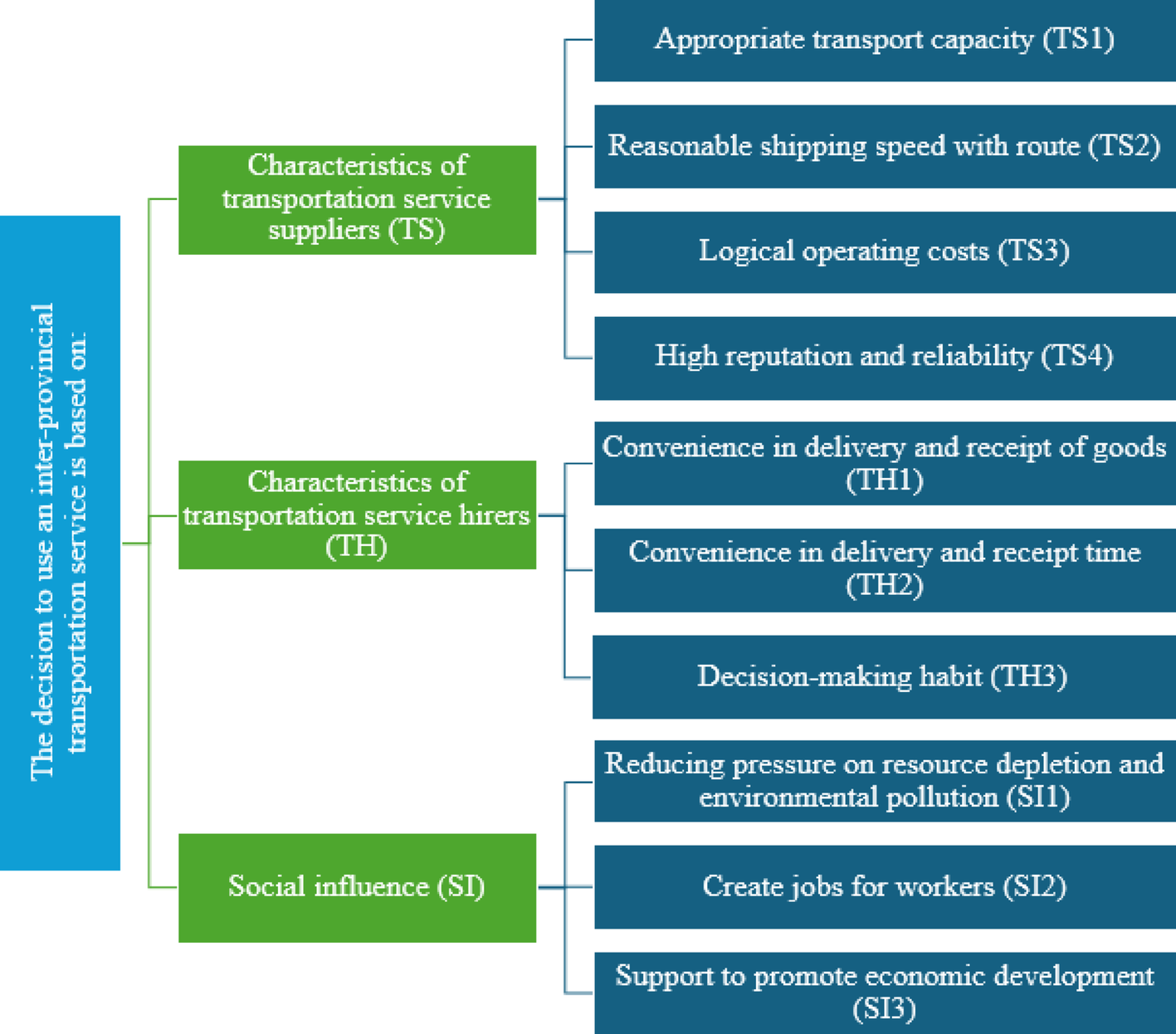INTER-PROVINCIAL TRANSPORTATION OF GOODS FROM HO CHI MINH CITY IN THE CONTEXT OF THE CIRCULAR ECONOMY DEVELOPMENT
Published in Sustainability

The circular economy is an economic model in which design, production, and service activities aim to extend the life of materials and eliminate negative environmental impacts. The transition to a circular economy is a great opportunity for sustainable development to achieve socio-economic and environmental goals and respond to climate change. For the logistics and transportation sector, promoting the demand for goods transported using low-emission modes of transport is also one solution that contributes to the common goal of sustainable development, especially in developing countries such as Vietnam. This study focuses on clarifying the criteria that make people in Ho Chi Minh City (the largest city and an important transport hub in Vietnam) choose inter-provincial freight transport services by road, a mode of transport that is considered to cause a relatively high emission rate. From there, these criteria will serve as the basis for proposing service improvement options for other low-emission modes of transport, thereby providing people with a variety of options for deciding to use inter-provincial freight transport services. The study was conducted using Analytic Hierarchy Process (AHP) analysis to identify the five most important factors affecting the ability to choose inter-provincial freight services in Ho Chi Minh City, which are, respectively, convenience in delivery and receipt of goods, service provider reliability, supplier selection habits, the reduction of pressure on resource depletion and environmental pollution, and service delivery speed.
Theoretical contributions
The circular economy is increasingly attracting the attention of academia, industry, and economic and social development strategists. The transition from a linear economy to a circular economy requires changes from the micro to the macro level. This study has explored and identified the core criteria that promote people's choice of transportation mode in Ho Chi Minh City when inter-provincial transportation is implemented in the context of promoting the development of the circular economy. As a result, the five most important factors affecting the ability to choose intercity freight services in Ho Chi Minh City identified, ranked in order of decreasing priority, are convenience in delivery and receipt of goods, service provider reliability, supplier selection habits, the reduction of pressure on resource depletion and environmental pollution, and service delivery speed.
Managerial contributions
Based on the aspect of promoting circular economic development, the governance implications are mainly aimed at two main subjects: the government and transportation service providers. With five important criteria identified from the research results, the authors have proposed managerial implications related to promoting the development of a circular economy through activities related to inter-provincial freight transport services. The proposed solutions aim to reshape the way freight transport services operate to stimulate people's demand, thereby making recommendations to the government on reforming investment in multimodal transport activities.
Enterprises should focus on improving service frequency, service capacity, and journey speed, changing and improving service delivery networks, building close links between parties involved in the freight transport flow, and integrating information management systems to ensure seamless information flow in the supply chain. Integrating technology into the freight transport route will become an important factor in determining enterprises' competitiveness as the 4.0 industrial revolution develops. The government will need to develop policies for businesses to create a nationwide transportation network proactively. At the same time, documents guiding how to deploy the service and favorable macroeconomic conditions for businesses to boldly form this type of service will be needed.
Methodology
The Analytic Hierarchy Process (AHP) is one of the multi-objective decision-making methods proposed by Thomas L. Saaty. AHP is a quantitative method used to evaluate the priority or importance of decision alternatives. It allows clear visibility of the evaluation criteria and their associated attributes and allows the researcher to obtain evaluation data to analyze the relative importance levels. The application of AHP in this study has contributed to providing evaluation perspectives for criteria to help determine optimal inter-provincial freight transport services.
Follow the Topic
-
Discover Sustainability

A multi-disciplinary, open access, community-focussed journal publishing results from across all fields relevant to sustainability research whilst supporting policy developments that address all 17 of the United Nations Sustainable Development Goals (SDGs).
What are SDG Topics?
An introduction to Sustainable Development Goals (SDGs) Topics and their role in highlighting sustainable development research.
Continue reading announcementRelated Collections
With Collections, you can get published faster and increase your visibility.
Advancing Sustainable Development: The Role of Circular Economy Practices, Green Innovation and Corporate Responsibility
Achieving sustainable development, as envisioned in the United Nations’ 2030 Agenda, requires transformative solutions to reconcile economic growth with environmental and social imperatives. Circular economy practices, green innovations, and corporate responsibility stand out as critical drivers in this effort—reducing resource depletion, fostering innovation, and embedding accountability into global systems. Yet, their combined potential to accelerate progress toward the Sustainable Development Goals (SDGs) remains underexplored. This Collection aims to unravel these synergies, offering actionable insights for researchers, policymakers, and practitioners committed to a sustainable future.
Keywords: Sustainable Development, Circular Economy Practices, Green Innovation, Corporate Responsibility, Challenges and Opportunities in Sustainable Development.
This Collection supports and amplifies research related to SDG 7, SDG 12, SDG 13 and SDG 17.
Publishing Model: Open Access
Deadline: Apr 01, 2026
Transforming Education for Innovation, Sustainability, and Social Responsibility
Education plays a key role in addressing today’s global challenges, including climate change, social inequalities, and technological changes. As the world becomes more complex, education must transform to prepare students for the future. This Collection will explore how education can support innovation, sustainability, and social responsibility. By focusing on new teaching methods, policies, and institutional changes, this issue aims to contribute to meaningful educational reforms. Research in this area will help create a learning environment that fosters problem-solving, critical thinking, and ethical decision-making among students.
Technological advancements such as artificial intelligence, automation, and digital transformation are changing how people work and learn. To keep up with these changes, education must teach the skills needed for the future (SDG 9). Climate change is another major challenge that requires education systems to focus on sustainability and environmental awareness (SDG 13). Social and economic inequalities make it difficult for many people to access quality education and opportunities for success (SDG 10). Education must become more inclusive and fairer, ensuring equal opportunities for all (SDG 4). Additionally, global challenges like migration, cultural diversity, and human rights require an education system that promotes ethical responsibility and global citizenship (SDG 16). Many education systems are outdated, face funding issues, and struggle to adapt to modern needs, highlighting the need for research that guides policy improvements (SDG 4).
This Collection supports several United Nations Sustainable Development Goals (SDGs), including SDG 4 (Quality Education), SDG 9 (Industry, Innovation, and Infrastructure), SDG 10 (Reduced Inequalities), SDG 13 (Climate Action), and SDG 16 (Peace, Justice, and Strong Institutions). Education for sustainability fosters environmental awareness and responsible actions (SDG 13). Innovation in education drives technological and economic growth (SDG 9). Ensuring access to quality education promotes social equity (SDG 10). Encouraging social responsibility in education helps create a more just and ethical society (SDG 16).
We invite researchers to submit original papers for this Collection, welcoming various research approaches, including conceptual, empirical, and analytical studies. The scope of this Collection includes topics related to education, sustainability, and social responsibility. Suggested areas of interest include but are not limited to the following:
• Innovative Teaching Methods for the 21st Century
• Technology and Digital Transformation in Education
• Policy and Governance for Educational Reform
• Climate Change and Sustainability Education
• Equity and Inclusion in Education
• Ethics and Social Responsibility in Education
• Global Citizenship and Cross-Cultural Education
• Education for Employability and Skill Development
• Artificial Intelligence and Education
• Green Campuses and Sustainable Learning Environments
• Training for Sustainability and Innovation
• Community Engagement and Public Awareness through Education
• Promoting Green HRM, Marketing, Leadership, & Entrepreneurship in Education
The target audience for this Collection includes researchers, policymakers, educators, and professionals involved in educational reform, sustainability, social sciences, and technology. Contributions from different regions and contexts are encouraged to provide a global perspective on these issues. By fostering research on innovation, sustainability, and social responsibility in education, this Collection aims to contribute to global efforts in transforming education. We look forward to high-quality submissions that help shape the future of education.
This Collection supports and amplifies research related to SDG
Keywords: Educational Innovation; Sustainability Education; Social Responsibility; Digital Transformation; Global Citizenship; Policy Reform in Education; Inclusive Education; AI in Education; Climate Action; SDGs and Education
Publishing Model: Open Access
Deadline: Jan 31, 2026




Please sign in or register for FREE
If you are a registered user on Research Communities by Springer Nature, please sign in
Hello how i can contact you?....I have an idea of project that it can interesting you
You can email me at hadtt@uef.edu.vn. Thank you for sharing your interest in this topic :)